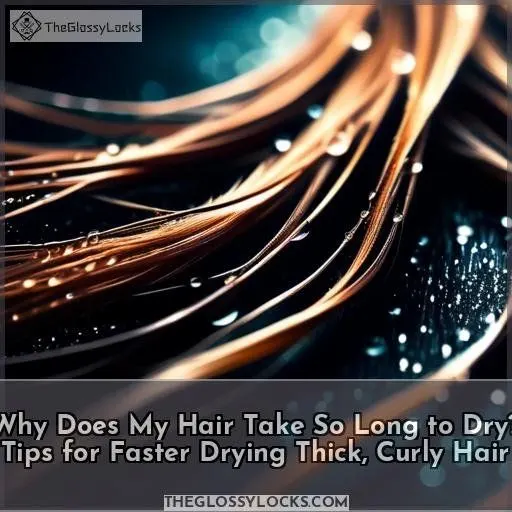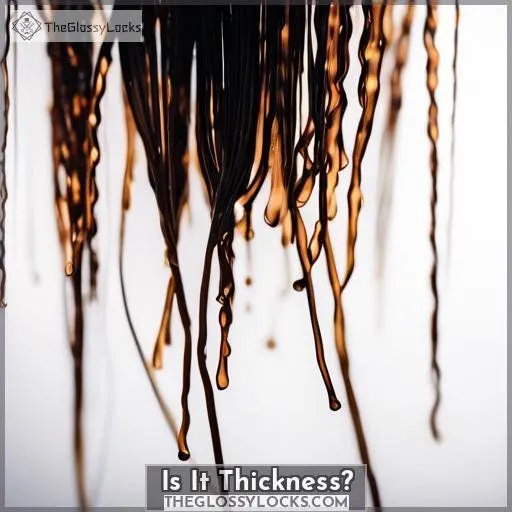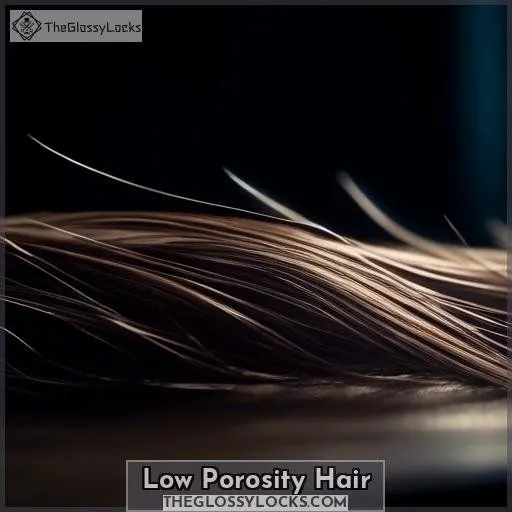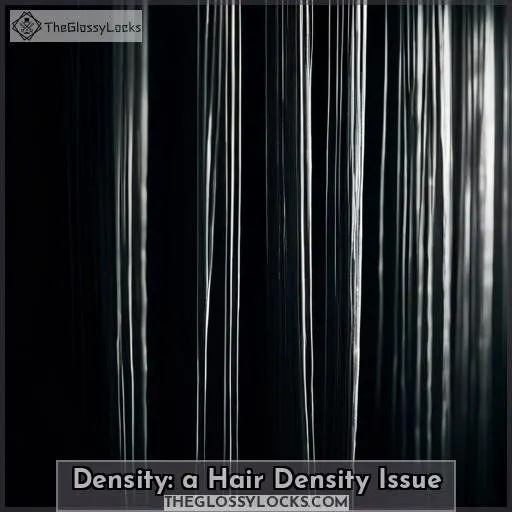This site is supported by our readers. We may earn a commission, at no cost to you, if you purchase through links.

Low porosity means your strands resist water absorption, making it harder for moisture to evaporate.
Curly or coily textures trap moisture within the curl formation, obstructing airflow.
High density equates to more strands per square inch, further prolonging drying time.
However, slow drying can also signify healthy, well-hydrated hair.
To learn quick-drying techniques that are customized to your hair type and discover the secrets behind accelerating the drying process, we’ll explore factors like thickness, porosity, and curl definition.
Table Of Contents
Key Takeaways
- Hair takes longer to dry due to factors like thickness, porosity, and density, which can obstruct airflow and make it harder for moisture to evaporate.
- Low porosity hair is particularly resistant to water absorption, making it harder for products to penetrate and for moisture to escape.
- Curly or coily strands have a unique structure that can trap moisture and obstruct airflow, making it harder for hair to dry completely.
- Healthy hair tends to dry more slowly, and it’s important to avoid excessive heat to maintain hair health.
Why Does My Hair Take So Long to Dry?
Your hair’s drying time is influenced by multiple factors.
Primarily, the volume and length of your hair increase its surface area and density, extending its drying duration.
Additionally, hair with high porosity rapidly absorbs water but may take longer to dry as it retains moisture for a prolonged period.
Environmental factors also impact the process.
High humidity hinders evaporation and low humidity accelerates drying.
Hair density can contribute to moisture retention, prolonging drying time compared to finer hair types.
Finally, curly and coily hair dries more slowly as water must navigate its twists and turns.
To expedite the drying process, consider using a towel to gently remove excess moisture.
Employ a wide-tooth comb or diffuser attachment during blow-drying.
Apply hair products to wet hair to enhance absorption.
Is It Thickness?
Your thick hair takes longer to dry because it has larger, heavier strands that require more time to absorb and release moisture.
Additionally, thick hair often has a higher density, which reduces airflow and increases drying time.
To speed up the drying process, you can use a diffuser with your hairdryer.
Apply quick-dry sprays.
Choose the right towel to absorb moisture without causing frizz.
Remember that slow drying can indicate healthy hair.
Be patient and avoid excessive heat to maintain hair health.
Low Porosity Hair
After addressing the thickness, let’s delve into the realm of low porosity hair. This type operates like a stringent sentinel against water absorption, rendering moisture retention an arduous task.
The dilemma? Facilitating products to infiltrate past the superficial level.
However, trepidation is unwarranted, as with appropriate styling methods and an emphasis on amplifying hydration levels, you can outmaneuver your hair’s porosity.
Envision it as deciphering the enigma to expedited drying times and more efficacious hair care, thwarting the triumph of your hair’s inherent barriers.
Curly or Coily Strands
Curly or coily strands can take longer to dry due to their unique structure. Here’s why:
- Curl Definition: The tighter the curl, the more twists and turns obstruct airflow, making it harder for water to escape.
- Curl Formation: Coils have a spiral shape that can trap moisture, making it harder for hair to dry completely.
- Curl Type: Different curl types have varying levels of porosity, which affects how quickly water can enter and exit the hair.
To speed up drying time for curly or coily hair, consider the following tips:
- Curl Care: Focus on maintaining curl definition and hydration to prevent excessive dryness.
- Curl Maintenance: Regularly detangle and moisturize to prevent breakage and keep curls healthy.
- Hair Hydration: Use products specifically designed for curly or coily hair to guarantee proper hydration and moisture retention.
Density: a Hair Density Issue
Hair density refers to the number of strands per square inch on your head. Thicker hair, with more strands per square inch, takes longer to dry. But don’t fret! Density can be influenced by factors like hair count, strand thickness, and diameter.
Consider this: If you have thick hair, it’s like having a fuller wardrobe – more pieces to choose from, but they all take time to air out. Similarly, with thicker hair, there are more strands to dry, which can increase drying time.
However, slow drying isn’t always a bad thing. Healthy hair tends to dry more slowly, and it’s important to avoid excessive heat to maintain hair health. So, be patient and embrace the process.
To speed up drying, use a quick-dry spray, choose the right towel, and be mindful of your hair products. Remember, the key is to find a balance between drying time and hair health.
Slow Drying: a Sign of Healthy Hair?
Slow drying hair can be a sign of healthy hair. Here’s why:
- Hydration level: Healthy hair is well-hydrated, absorbing and retaining moisture. This can make it take longer to dry.
- Product application: Using leave-in conditioners, heat protectants, and other hair products can extend drying time.
- High porosity hair: This hair type struggles to absorb moisture but retains it well, making it slower to dry.
Frequently Asked Questions (FAQs)
What is the best hair drying technique for thick hair?
For thick locks, it’s all about letting your hair air dry before using any heat tools. Grab a microfiber towel, gently squeeze out excess moisture, and let those luscious strands take their sweet time drying naturally. Trust me, your hair will thank you!
How can I speed up the drying time for low porosity hair?
Believe it or not, low porosity hair‘s resistance to moisture can work in your favor when drying. Use lightweight, water-based products to avoid buildup and try blow-drying with a cool setting to speed things up.
What are the best products to use for drying curly or coily strands?
For curly/coily strands, try a leave-in conditioner with slip like Cantu Coconut Curling Cream. Spritz in a curl refresher like As I Am Coconut Cowash to reactivate curls. Finish with a gel like Eco Styler for long-lasting moisture and definition.
How can I reduce drying time for hair with a high density?
You’re in for a real treat! Thinning your high-density locks through regular trims can work wonders for faster drying times. Embrace the sassy crop, and let those strands breathe freely.
Is it possible to dry hair faster without damaging it?
You can speed up drying without damage by gently blotting excess water with a microfiber towel, using a quick-dry spray, and rough drying with low heat before styling. Patience is key – healthy hair takes time!
Conclusion
Ultimately, understanding your hair’s thickness, porosity, curl pattern, and density unravels why your hair takes so long to dry. Properly prepping and patiently persevering through the drying process preserves precious moisture, preventing parched, porous strands. With personalized techniques customized to your tresses’ texture, you’ll achieve faster drying without compromising health and hydration.








